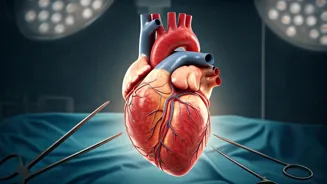PAD: Silent Threat
Peripheral artery disease (PAD) is frequently marked by leg pain that emerges when walking, however, it's more than just discomfort in the legs, acting
as a potential marker for a silent threat to the heart. PAD is a condition in which the arteries in the legs and feet become narrowed because of a buildup of plaque (atherosclerosis). This restricts blood flow, causing various symptoms, the most obvious of which is pain, especially during physical activity like walking. It's crucial to recognize this pain and see a doctor. Moreover, PAD is not solely a condition of the elderly, it can affect anyone, particularly those with risk factors such as smoking, diabetes, high blood pressure, and high cholesterol. Early recognition and management are critical, since PAD can result in serious complications such as heart attack or stroke, if not properly addressed. Addressing the issue early can significantly lower the risk of cardiovascular issues and improve overall health.
Understanding PAD Symptoms
PAD can show up in various ways, often beginning subtly, but progressing to become more pronounced. The most prominent symptom is leg pain, particularly in the calf muscles, when walking, an effect referred to as claudication. This pain happens because of the reduced blood flow when the legs are active. Pain can range from a mild ache to intense cramping and usually disappears when the person rests. Alongside leg pain, other indications might include numbness, weakness in the legs, and coldness in the lower extremities. The skin on the legs and feet may also change, appearing pale or bluish, and the feet may have slower hair growth. For some, PAD might manifest as sores or ulcers on the feet or toes that do not heal effectively due to poor blood circulation. It's vital to pay attention to these symptoms, especially in individuals with known risk factors, to enable early diagnosis and treatment. Ignoring such warning signs can lead to an escalation of the disease and the risk of more severe complications.
Causes and Risks
Several factors contribute to the development of PAD, with the primary cause being atherosclerosis, a condition where plaque accumulates inside the arteries. This build-up restricts blood flow, particularly to the legs. Risk factors elevate the chances of developing PAD, including smoking. Tobacco use damages blood vessels and speeds up the process of plaque formation. Diabetes is another significant risk factor; high blood sugar levels can damage the arteries and increase the risk of PAD. High blood pressure (hypertension) and high cholesterol levels also play a role, as they contribute to artery damage. Other factors include older age, as the risk increases with age, and family history of cardiovascular disease. Additionally, obesity and a sedentary lifestyle can elevate the chances of PAD. Understanding these risk factors and adopting preventive measures like maintaining a healthy lifestyle, avoiding smoking, and managing underlying health conditions are essential in reducing the chance of developing PAD and keeping blood vessels healthy.
Managing and Treating PAD
If PAD is suspected or diagnosed, there are several management and treatment options available to manage the condition. Lifestyle modifications form the base of treatment. This involves quitting smoking, since smoking significantly worsens PAD. Regular exercise, especially walking, can improve blood flow and alleviate pain. Maintaining a healthy diet, low in saturated and trans fats, can help control cholesterol levels and prevent further plaque buildup. Medications are often prescribed to manage symptoms and decrease the risk of complications. These might include medications to lower cholesterol, blood pressure, and to control blood sugar if diabetes is present. Antiplatelet medications, like aspirin or clopidogrel, may be prescribed to reduce the risk of blood clots. In some cases, more advanced interventions are necessary. Angioplasty, where a balloon is inserted into the narrowed artery to widen it, and stenting, in which a small mesh tube is placed to keep the artery open, are options. Bypass surgery, a procedure to reroute blood flow around the blocked artery, is another surgical option. Working with healthcare professionals to find the best approach is key to handling PAD, easing symptoms, and preventing complications.
When to Seek Help
Knowing when to seek medical attention for leg pain is essential to manage PAD and any related problems. Consult a doctor if you experience persistent leg pain, especially if it occurs when walking and is relieved by rest. Any sores or ulcers on your feet or toes that fail to heal or are slow to heal need medical attention. Other concerning symptoms are numbness, weakness, or coldness in your legs or feet, which might indicate inadequate blood flow. A change in the color or texture of the skin on your legs or feet may also be a sign of PAD. Anyone with risk factors like smoking, diabetes, high blood pressure, or a family history of cardiovascular disease should be particularly alert to these symptoms and seek medical advice. Early intervention is critical to avoid complications like severe limb pain, infections, and potential loss of a limb. Regular check-ups and prompt reporting of symptoms can contribute to early diagnosis and effective management, which will drastically improve your chances of living a healthy life.


